Aeoniums Profile
Written by Iris
Aug 09 2021
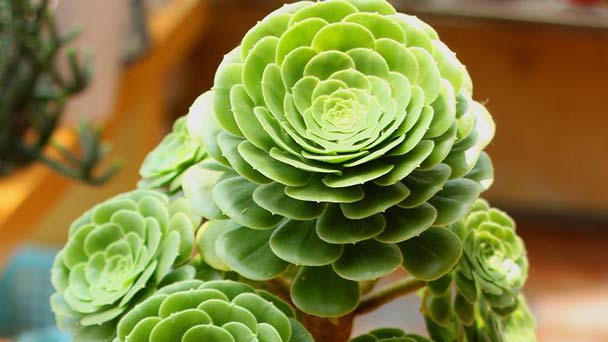
Among succulent plants, Aeonium is one of the most notable. If you decide to bring this beautiful plant into your home, you need to learn a few tricks to ensure you take good care of the lovely succulent. Fortunately, this article will provide you with a guide that will help you understand all the basic grow and care measures for Aeonium.
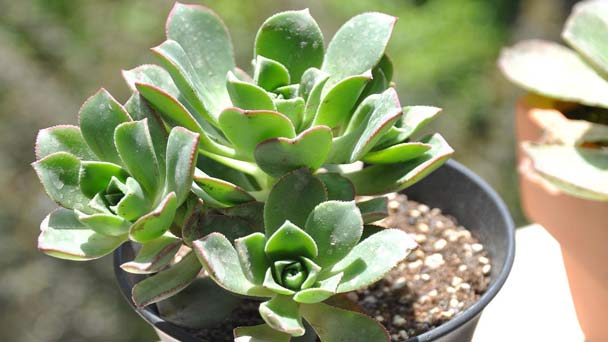
Wild aeoniums prefer solitude, and you can find them living alone on rocky hillsides. Aeoniums grow in clusters and stay away from other plants. Aeoniums will need at least six hours of sunlight to develop fully colored leaves. Once an aeonium succulent matures, it can produce flowers on a stem. The stem of Aeoniums is about 8 inches tall, and the flowers are grouped at the tip. The Aeoniums flowers can be pink, red, white, yellow, or gold. The color once again depends on the specie.
Winter is the growing season for these succulents. However, Aeoniums can't stand frost or cold weather. If you live in such a place, keep your aeoniums indoors. On the other hand, aeoniums can survive droughts because of their unique way of storing water inside the leaves.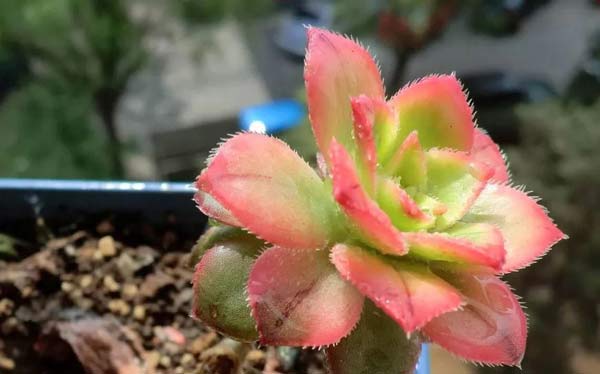
The selection of soil is entirely up to you. Keep in mind that succulent growers often recommend filling up a pot with regular planting soil, and mixing it up with a cactus potting mix. Remember to use a well-draining clay pot.
Once the Aeoniums stem is all healed up, put it into the soil. It should stand straight. Place the pot somewhere warm and sunny, and water the succulent once a week. There is no need to go overboard, a small amount of water is enough.
Your new aeonium will be ready for replanting as soon as it develops a root system. Let the top layer of the soil dry before you start repotting the plant. Stop watering the succulent for a couple of days and check the ground with your finger. Then you can transfer your aeonium either into a bigger pot or to your garden.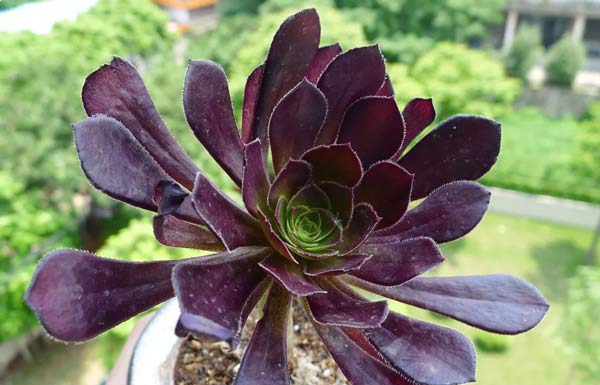
Aeonium arboreum 'Atropurpureum': This 3- to 5-foot tall cultivar has maroon leaves if grown in bright light.
Aeonium arboreum 'Zwartkop': This cultivar has very dark, almost black leaves. It, too, is a fairly large plant.
Aeonium 'Garnet': A hybrid cross of A. 'Zwarkop' and A. tabuliforme, this variety's leaves are green toward the middle and tipped with dark red.
Aeonium davidbramwelli 'Sunburst': This variety is a shorter, 1- to 2-foot tall plant but has rosettes up to 1 foot across with pale yellow, white and green stripes, and pink tips.
Aeonium haworthii 'Tricolor' or 'Kiwi': An easy growing 2- to 3-foot plant, it has 4-inch flowers that have pale yellow centers when young, maturing to red and green.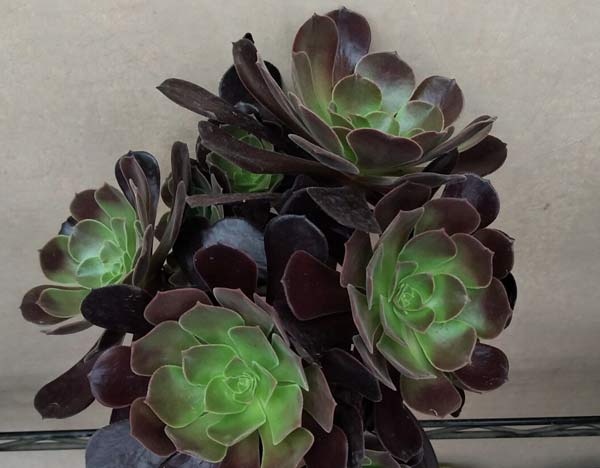
Aphids (Greenflies or Plant Lice)–These are small insects with fat, teardrop-shaped bodies. They can be found sucking on Aeoniums leaves or flowers at the end of the stems, on the leaves and the undersides of the plant.
Treat Aeoniums with a mixture of soapy water. Add a few drops of dish soap in 1-2 cups of water and mix well. Spray onto infested areas and undersides of the leaves. You can also add vegetable oil to the soapy water. Put a few drops of dish soap in 1-2 cups of water with about 1 teaspoon of vegetable oil and mix well. Spray onto the infested areas where you see the bugs. Neem oil have also been used to treat and keep aphids away.
Mealybugs-Aeoniums are particularly susceptible to mealybugs. They are tiny and very easy to miss. An early sign your plants have mealybugs is the white cottony substance you see on your Aeoniums.
Use a cotton swab or Q-tip dipped in rubbing alcohol and apply directly on the bugs and anywhere you see the white cottony substance. Alternatively, you can use a spray bottle and spray rubbing alcohol directly onto the bugs and white fluff. Some people like to dilute the alcohol about half strength with water .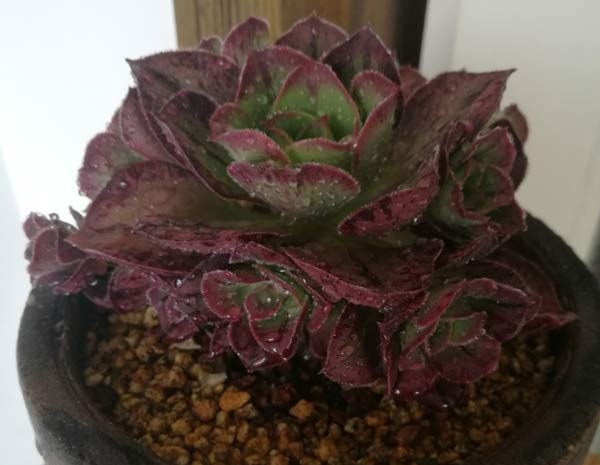
Aeoniums PictureAeoniums InfoAeoniums HistoryEcological Habits of AeoniumsAeoniums Distribution AreaHow to Grow and Care for AeoniumsVarieties of AeoniumsAeoniums Common Pests/Diseases
Aeoniums Picture

Aeoniums Info
| Latin Name | Aeonium spp. |
| Common Names | Aeonium |
| Plant Type | Perennial succulent |
| Mature Size | 2–60 inches (depending on species and variety) |
| Sun Exposure | Full sun to part shade |
| Soil Type | Sandy loam |
| Soil pH | 5.6–6.0 (slightly acidic) |
| Bloom Time | Late winter or spring |
Aeoniums History
The plant's botanical name Aeonium comes from the Greek word, aionos, which means “ageless.” Aeonium plants seem to be ageless as new rosettes take the place of those that bloom and die. The common name of this entire genus is “Tree Houseleek” because of its growth habit. For the most part, Aeoniums grows on a stalk or trunk rather than nestling close to the ground as do similar succulents.Ecological Habits of Aeoniums
Aeoniums are perennial succulents that form rosettes. The fleshy triangular leaves of Aeoniums can be green, yellow, red, or even purple, depending on the specie you choose. A mature aeonium succulent can grow from 2 to 60 inches. aeoniums can adapt to a variety of temperatures all around the globe. Several Aeonium species form shrubs. These Aeoniums can be up to 60 inches tall. The elongated stems have rosettes at the top.Wild aeoniums prefer solitude, and you can find them living alone on rocky hillsides. Aeoniums grow in clusters and stay away from other plants. Aeoniums will need at least six hours of sunlight to develop fully colored leaves. Once an aeonium succulent matures, it can produce flowers on a stem. The stem of Aeoniums is about 8 inches tall, and the flowers are grouped at the tip. The Aeoniums flowers can be pink, red, white, yellow, or gold. The color once again depends on the specie.
Winter is the growing season for these succulents. However, Aeoniums can't stand frost or cold weather. If you live in such a place, keep your aeoniums indoors. On the other hand, aeoniums can survive droughts because of their unique way of storing water inside the leaves.

Aeoniums Distribution Area
Most of Aeoniums are hybrids of the few natural populations remaining on the Atlantic Moroccan coast (source: University of Wisconsin Master Gardener Program). All aeoniums may originated from the Canary Islands but in fact, aeoniums had their start from different parts of the Atlantic (besides the aforementioned, also from Madeira and the Cape Verde Islands).How to Grow and Care for Aeoniums
How to Grow Aeoniums
- With Stem Cuttings
The selection of soil is entirely up to you. Keep in mind that succulent growers often recommend filling up a pot with regular planting soil, and mixing it up with a cactus potting mix. Remember to use a well-draining clay pot.
Once the Aeoniums stem is all healed up, put it into the soil. It should stand straight. Place the pot somewhere warm and sunny, and water the succulent once a week. There is no need to go overboard, a small amount of water is enough.
Your new aeonium will be ready for replanting as soon as it develops a root system. Let the top layer of the soil dry before you start repotting the plant. Stop watering the succulent for a couple of days and check the ground with your finger. Then you can transfer your aeonium either into a bigger pot or to your garden.
How to Care for Aeoniums
- Light
- Soil
- Water
- Temperature
- Fertilizer
- Pruning
- Aeoniums Design Tips

Varieties of Aeoniums
Aeonium arboreum: This widely available plant has bright green rosettes on a branching stem. It has a shrubby form and can grow as tall as 6 feet in the garden, or 3 feet in containers.Aeonium arboreum 'Atropurpureum': This 3- to 5-foot tall cultivar has maroon leaves if grown in bright light.
Aeonium arboreum 'Zwartkop': This cultivar has very dark, almost black leaves. It, too, is a fairly large plant.
Aeonium 'Garnet': A hybrid cross of A. 'Zwarkop' and A. tabuliforme, this variety's leaves are green toward the middle and tipped with dark red.
Aeonium davidbramwelli 'Sunburst': This variety is a shorter, 1- to 2-foot tall plant but has rosettes up to 1 foot across with pale yellow, white and green stripes, and pink tips.
Aeonium haworthii 'Tricolor' or 'Kiwi': An easy growing 2- to 3-foot plant, it has 4-inch flowers that have pale yellow centers when young, maturing to red and green.

Aeoniums Common Pests/Diseases
Aeoniums are not immune to common pests that bug succulents. Fortunately, they are resilient and hardy plants and can handle almost anything, even a bad infestation. Here are some common pests that can damage aeoniums:Aphids (Greenflies or Plant Lice)–These are small insects with fat, teardrop-shaped bodies. They can be found sucking on Aeoniums leaves or flowers at the end of the stems, on the leaves and the undersides of the plant.
Treat Aeoniums with a mixture of soapy water. Add a few drops of dish soap in 1-2 cups of water and mix well. Spray onto infested areas and undersides of the leaves. You can also add vegetable oil to the soapy water. Put a few drops of dish soap in 1-2 cups of water with about 1 teaspoon of vegetable oil and mix well. Spray onto the infested areas where you see the bugs. Neem oil have also been used to treat and keep aphids away.
Mealybugs-Aeoniums are particularly susceptible to mealybugs. They are tiny and very easy to miss. An early sign your plants have mealybugs is the white cottony substance you see on your Aeoniums.
Use a cotton swab or Q-tip dipped in rubbing alcohol and apply directly on the bugs and anywhere you see the white cottony substance. Alternatively, you can use a spray bottle and spray rubbing alcohol directly onto the bugs and white fluff. Some people like to dilute the alcohol about half strength with water .

Aeoniums Companion Plants
Aeoniums do well in shallow pots with a mixture of cactus soil and peat. You can combine Aeoniums with other plants such as aloe, agave, or jade plants. Place a thin layer of inorganic mulch such as ornamental rock around the plants and place in a sunny, warm location.
Latest Updated
- Benefits of Bugleweed - 7 Science-backed Health Benefits
- Bugleweed Dangers & Side Effects - Is It Poisonous?
- How to Plant Evergreen Trees - What You Should Know
- When to Plant Evergreens - Grow Guide for Evergreen Trees
- 12 Wonderful Evergreen Shrubs for Your Garden
- 12 Popular Evergreen Plants with Pictures for Beginners
- When And How To Prune A Lilac Bush Like a Pro
- How to Grow & Care for Lilac Vine (Hardenbergia Violacea)
- Japanese Lilac Tree (Syringa Reticulata) Care & Propagation Guide
- Shumard Oak Pros and Cons - What to Know
Popular Articles
- Winter maintenance of Antirrhinum Majus
- How to Grow Terminalia Mantaly Tree
- How to Grow and Care for Crossostephium Chinense
- How to grow Antirrhinum Majus in spring
- Peristeria Elata (Dove Orchid) Profile: Info & Care Guide
- Underwatered Snake Plant (Sansevieria Trifasciata) - Signs And How To Fix
- How to Care for Brazilian Jasmine Plant (Mandevilla Sanderi)
- How to Grow & Care for Graptopetalum Purple Delight in Summer
- Rosa Chinensis (China Rose): Plant Growing & Care Tips
- How to Care for Baby Sun Rose (Aptenia Cordifolia)